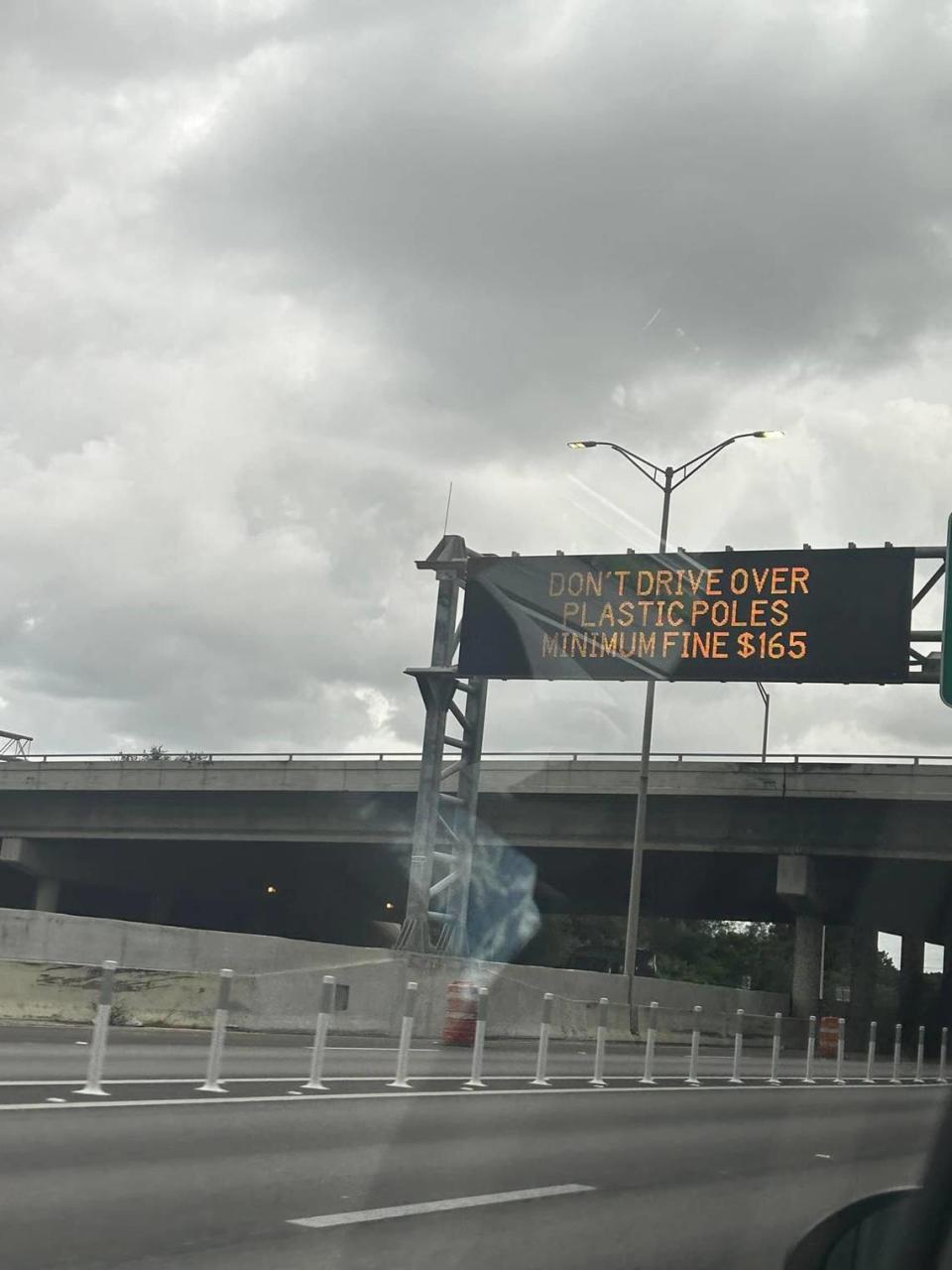How can drivers enter the I-95 express lanes? Where are the poles? What the law says
What’s with the rows of poles on Interstate 95?
I-95 has designated places to enter and exit the express lanes in Broward and Miami-Dade. And the poles have a job to do, although some of them are just lying down on the job.
Here’s what to know about the express lanes and the plastic poles:
Where are the highway poles?
Location: I-95 express lanes in Miami-Dade and Broward counties have designated entrance and exit points, and the plastic poles were installed to keep people in their respective lanes.
Where can drivers enter I-95 express lanes?
The I-95 express lanes, mostly separated from the general lanes by the plastic poles, run from downtown Miami to Broward Boulevard.
Here’s a breakdown of the entry points:
Northbound:
▪ Just north of State Road 836, SR 112, or Northwest 10th Avenue at 39th Street
▪ Just south of Miami Gardens Drive
▪ Just south of Hallandale Beach Boulevard
Southbound:
▪ Broward Boulevard Park & Ride, south of Sunrise Boulevard or just south of Stirling Road
▪ Just south of Ives Dairy Road
▪ Golden Glades Park & Ride, Northwest 151st Street
Where can drivers exit the I-95 express lanes?
Here’s a breakdown of the departure points:
Northbound:
▪ Florida’s Turnpike/State Road 826
▪ Just south of Ives Dairy Road
▪ South of Griffin Road
▪ Just North of Ives Dairy Road
Southbound:
▪ Ives Dairy Road
▪ Florida’s Turnpike/State Road 826
▪ Just north of State Road 836
▪ Just south of Miami Gardens Drive
What to know about the lane poles

Design: The plastic poles — no, they’re not metal or concrete despite appearances — can be run over, usually without major damage to a vehicle. Some of the poles on the stretch of southbound I-95 from Broward through the Golden Glades to State Road 826 show the wear and tear. They are bent, dinged or missing.
Reaction: “While the plastic poles are supposed to keep drivers in their respective lanes, we continue to see a system that simply does not work,” Stuart Weissman, a partner at Miami-based trial firm Ratzan Weissman & Boldt, wrote in a commentary on highway safety published earlier this year by the Miami Herald. “Because the poles are made out of flimsy plastic, they are prone to being damaged and completely broken. When this occurs, gaps in between the poles let drivers dangerously move between express lanes and regular lanes. The practice, known as “lane diving,” can cause horrific wrecks at high speeds.”
Law enforcement: It’s illegal to violate the poles to enter or exit express lanes. Electronic signs over the highway warn drivers with this message: “Don’t drive over plastic poles — Minimum fine $165.”
Background on the highway poles
Why poles? Highway planners have said there isn’t enough room to build barriers or walls to separate the express lanes.
Overhaul in 2016: About seven years ago, the Florida Department of Transportation installed sturdier poles with narrower gaps to discourage drivers diving into lanes they are not supposed to be in. Some observers consider that safer, to prevent cars from slipping through when one gets knocked down, but others say smaller gaps affect visibility on the highway.
What to know about the I-95 express lanes
Where they run: Originally, there were seven miles of express lanes along I-95 in Miami-Dade. Now the lanes extend from the junction of I-95 and State Road 836 near downtown Miami to Broward Boulevard near Fort Lauderdale, a 21-mile stretch.
Tolls: Express lanes use a “dynamically priced toll,” which means that the toll price shifts depending on how much traffic is on the road. The minimum toll is 50 cents at each toll point, and there are three toll points in each direction along I-95. So, if you were to drive in the express lane on I-95 from start to end, you should expect to pay a minimum of $1.50 for the trip. During rush hour or other high-traffic times, the tolls can rise — steeply. During one recent morning rush hour, the toll from Broward to State Road 836 in Miami flashed $11, then dipped to $9. More often, the tolls range from $1.50 to $3.50 at each point. You can only pay using an active SunPass account. The Sunpass device or decal is scanned from your dash or window at automatic checkpoints. Neither cash nor toll by plate is accepted.
Free travel: Certain drivers can use the express lanes for free if they register their vehicles. Here are the free categories: carpools of three or more commuters, hybrid vehicles, vanpools of 5 to 15 commuters, motorcycles.

